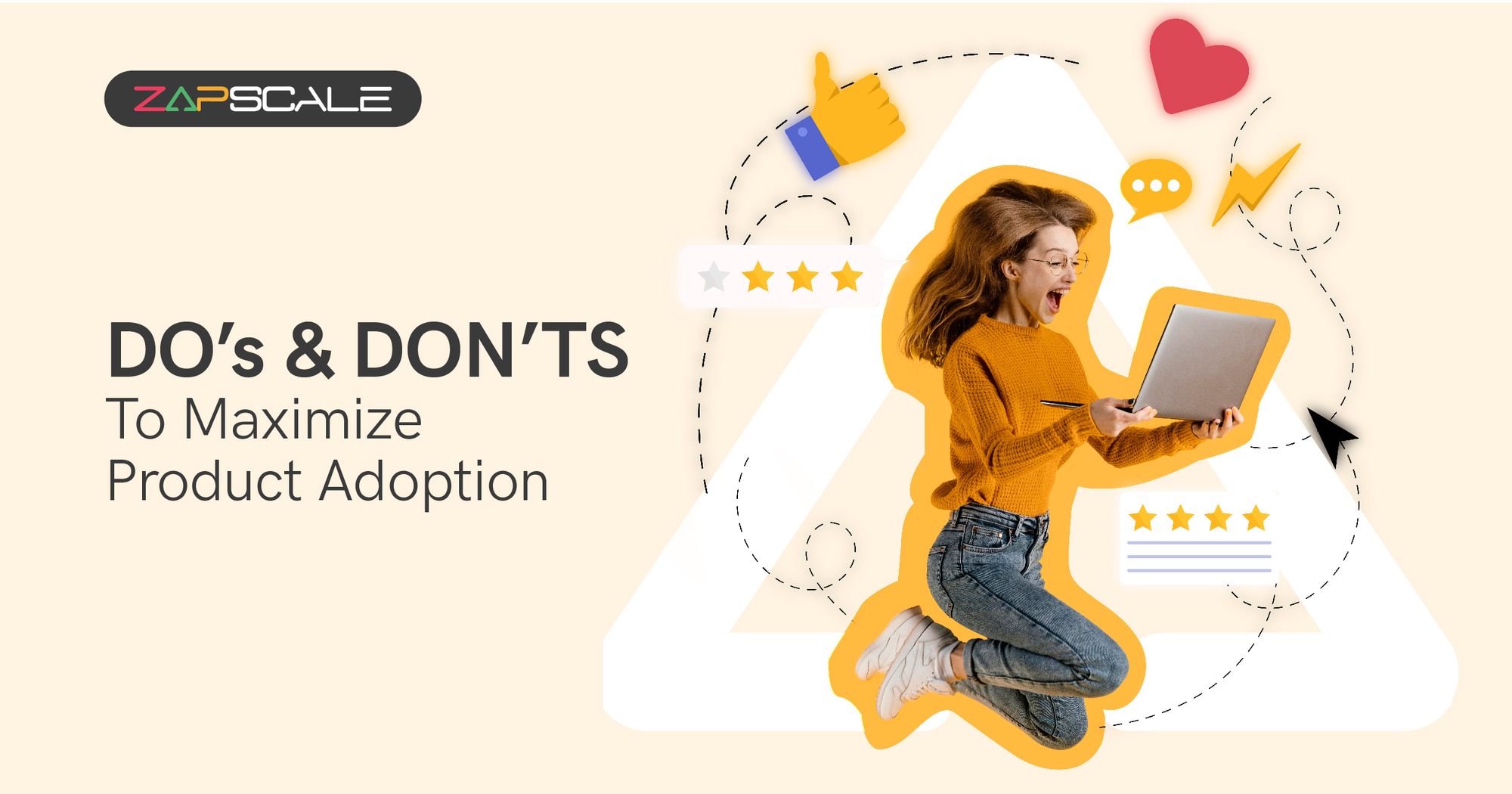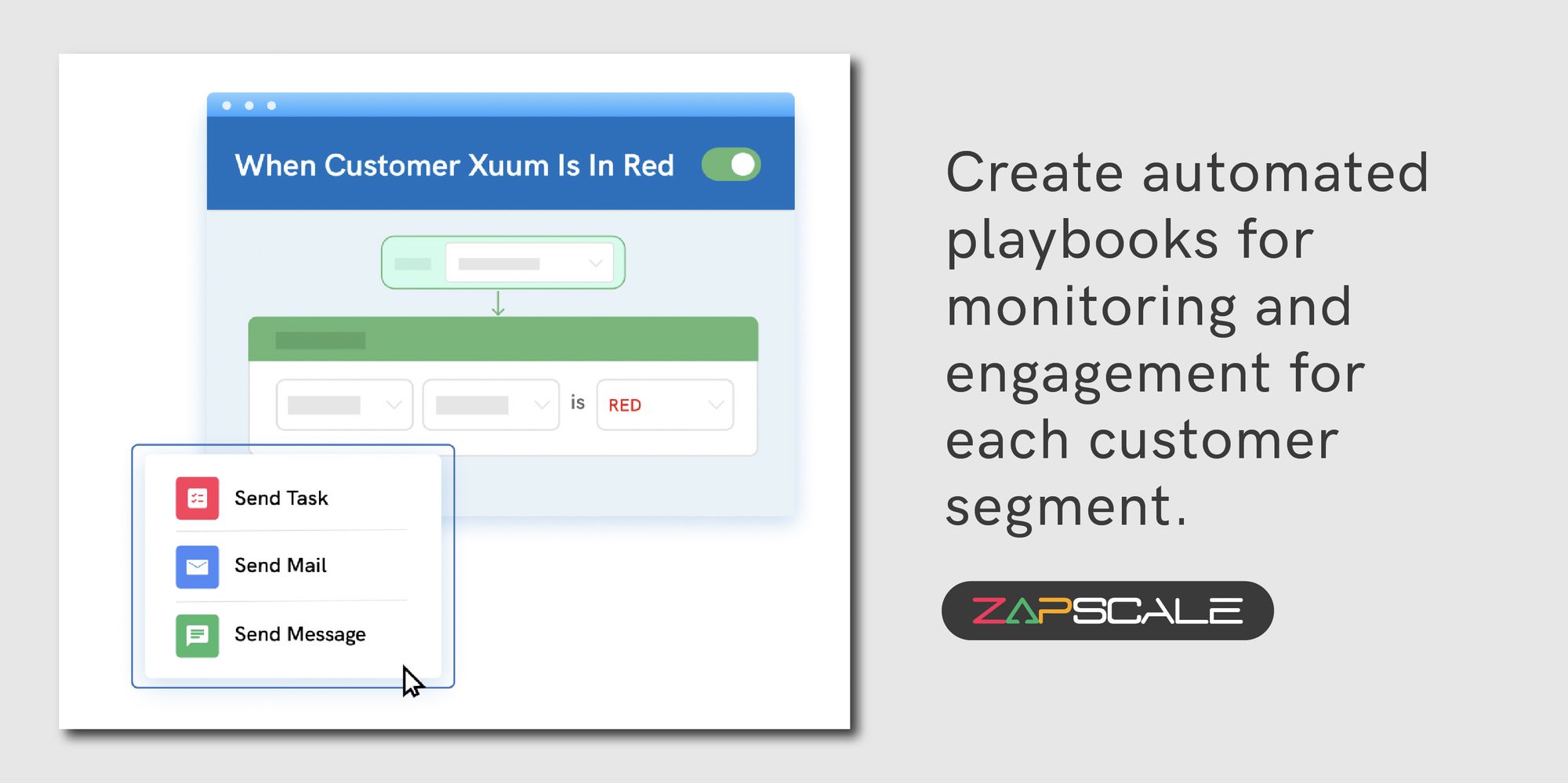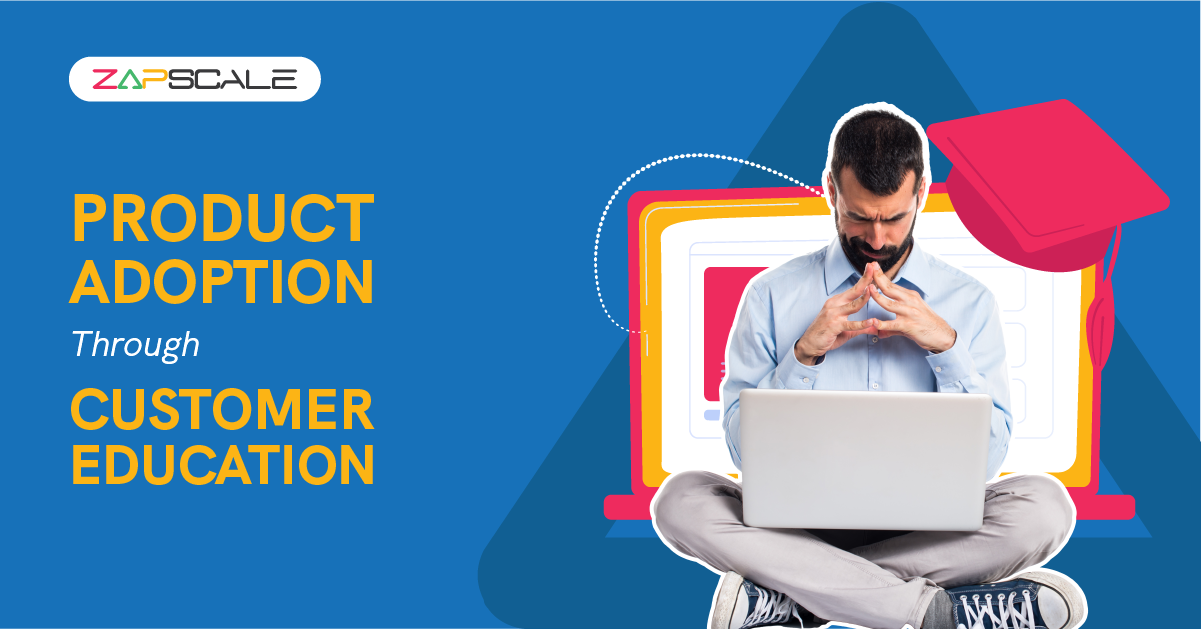CATEGORY > Product Adoption
5 Do’s and Don’ts To Increase Product Adoption

Acquiring new customers is an essential aspect of any business as it helps the company to grow and expand its customer base. Getting new customers can be a thrilling experience because it means that people are interested in the product or service that the company is offering. It also provides an opportunity for the business to showcase its products or services to a wider audience and potentially increase its revenue.
While acquiring new customers is important, it is also essential for you to
prove the value of your product. The first 30 days after a new customer buys your SaaS product are very crucial for building a strong relationship and delivering what they were promised in the sales pitch.
The biggest challenge is how you introduce your product in their daily routine and make them use your product regularly, in a way that is both desirable and beneficial to them.
After having extensive conversations with more than 100 customer success professionals, I’ve tried to consolidate my learnings in this article, in the form of 5 Do’s and Don’ts to increase product adoption.
What is Product Adoption?
Product adoption is the process in which your customers embrace and incorporate your product/service in their daily operations to accomplish their desired outcome or business objective. Successful product adoption hinges on multiple factors such as the product’s user-friendliness, scalability, and effective alignment with the customer’s specific needs and requirements.
Given the dynamic and fast-paced nature of the SaaS industry, where there is rapid innovation and advancement, product adoption becomes a crucial metric for SaaS businesses to evaluate product-market fit and business sustainability.
How to measure Product Adoption Rate?
To calculate the product adoption rate, you need 2 critical pieces of data from your product and user analytics:
1. New Active Users:
The number of people who completed a set number of key actions in the given period
2. New Users or Signups:
The number of people who signed up or subscribed to the product in a given period
Once you have these numbers, you’re ready to calculate your adoption rate using this formula:
Let’s understand with the help of an example:
- Let’s assume you’re measuring your adoption rate for the previous month. You had 30 active users and 50 new sign-ups on the product.
- So, the adoption rate will be – (30/50)100 = 60%
- This means that 60% of people who signed up for your product adopted it and became active and core users.
- On the flip side, 40% of the people ended up not using the product, and you may very likely lose them as paying customers.
(There are many ways to calculate product adoption but this one is what I've seen many CS teams follow. You will find other formulas for calculating product adoption here.)

Why Should You Improve Product Adoption?
There are multiple reasons why increasing product adoption is crucial for SaaS companies:
1. Increased Revenue and Predictability
SaaS businesses rely on recurring revenue from businesses. When your users actively engage with the product, it increases the likelihood they’ll find value and stay with you, leading to a more consistent revenue stream. Studies show retaining existing customers is significantly cheaper than acquiring new ones, so focusing on adoption can be a more cost-effective way to grow.
2. Reduced Churn
When your customers cannot adopt your product or get value out of it, they most likely churn or cancel their subscription. Improving product adoption helps users realize the product’s benefits, leading to higher customer satisfaction and lower churn.
3. Sustainable Growth
Highly engaged users are more likely to become advocates for your product, they’re more likely to recommend it to others and drive organic growth. Additionally, users who deeply understand the product’s value are more receptive to upsells and cross-sells, opening doors to further revenue streams.
4. Provides Valuable User Insights
By tracking user behavior and adoption rates, you gain insights into how users interact with your product. This can help identify areas for improvement, prioritize feature development, and ensure your product stays aligned with user needs.
Improving product adoption creates a win-win situation. Users get more value and become loyal customers, while your business enjoys a stable revenue stream, reduced churn, and opportunities for further growth.
5 Do’s To Maximize Product Adoption
Now, before you get lost in the math, let’s look back at how we can increase product adoption. Here are 5 great ideas to speed up the product adoption process and drive sustainable business growth:
1. Know your customer
I know it sounds obvious and basic, but understanding your customers is crucial to providing them with the best possible experience. By knowing their pain points and needs, you can tailor your product or service to meet those needs more effectively.
Additionally, keeping track of customer information in one place makes it easier to help them with their questions/problems and offers more personalized support, which can go a long way towards building strong customer relationships.

2. Leverage customer segmentation to improve engagement
If you want to improve your product adoption and help customers reach the ‘Aha!’ moment, you need to provide them with helpful tips for them to make the most out of your product.
Figure out which features of the product they’re using the most and the least.

Then, reach out to your customers with recommendations on what they’re missing out on and how utilizing the unused features can offer them additional benefits. But keep in mind that not all customers are alike and you need to create different personas to tailor your engagement accordingly.

3. Tailor your engagement based on the customer journey
As I mentioned in the previous section, you cannot treat every customer the same way. While crafting engagement with customers, it is important to keep in mind that every customer is at a different stage in their journey.
For example, overburdening a new customer with excessive product information might not be a good idea. Instead, they must be introduced with the basic features first and then gradually with the more advanced features.
Similarly, for loyal customers, it's crucial to not give them the information they already know and to personalize the engagement approach based on their journey to keep them satisfied and happy.

4. Drive towards simplification
In a world full of information overload, no one has the time to read a long and boring email. Try to keep your communication short and crisp, and use simple language that is easy to absorb. In case you need to share a ton of information, try to share it piecemeal rather than all at once or even make quick tutorial videos. Always remember, less is more.
5. Enable in-app engagement
In-app engagement or messaging not only helps increase engagement but also helps to provide a seamless experience with less dependency on other messaging platforms. Your customers are likely to have a better experience when they can get help right within your app without having to stop what they're doing and go to their mailbox.
This makes your product a one-stop shop for all their business needs. It’s a win-win!
The above-stated Dos can significantly help you improve your adoption rate and ensure that the product fits the customers’ needs entirely.

5 Don’ts To Maximize Product Adoption
Now, let’s look at 5 don’ts (or mistakes to avoid) for a healthy product adoption process:
1. Neglecting end users
A lot of SaaS companies get so caught up in selling and marketing their product that they disremember the product’s end users – the ones who will be using the product the most. The problem lies in the fact that the vendors often (and mostly) talk to the key decision makers (usually the top-level executives) at the customer’s organization, who in most cases aren’t the ones to use the product.
This means that when customer success managers design the product orientation process, they often do it from a business perspective, not focusing so much on the end users, their skills, and their technical background.
The end users are the actual influencers and decision-makers of any organization when it comes to adopting a technical tool. Therefore, it is important to consider the end-user when creating resources for onboarding and training.
2. Misguided metric tracking
Metrics help you measure and monitor your actions, they’re the key to understanding how efficiently the customers are using your product. Hence you need to make sure that you’re measuring the right KPIs.
Checking how often people log in and log out is a good start, but it is not enough to measure their level of engagement with the product.
For example, the number of app downloads might not tell you so much about your business's growth. You need to dig a little deeper and find out how the customers are using the app, what features are they using, are they even using it in the most optimized way.
Daily and monthly active users are helpful metrics only when people are using all the features and getting optimum value from the product.
3. Overloading users with product orientation
When introducing your product to the customers, it is natural to be passionate and want to show off all the cool things your product can do. But it is even more important to be considerate and mindful of who’s on the other side of the table.
Sometimes, to introduce your product to the customer, you end up overwhelming them with all the information at once. Try to gradually introduce things in pieces so the customer can grasp and experience your product at their speed – which is always better than confusing your customer with 100 things when they haven’t even understood the basics yet.
4. Struggling to decide how to engage with different customers
If you have customers from different backgrounds with different business profiles, it can be arduous to figure out whom to prioritize and how. You might naturally want to give more attention to your high-profile customers, but that's not always the right approach.
It is essential to be strategic with your approach and make sure all your customers feel valued and motivated enough to stick with you for longer. A tech-touch engagement can help you extend your reach to everyone and ensure you're not neglecting anyone.
It's also important to consider where each customer is in their journey with your product. Ideally, people who are already using it regularly will need less attention than those who have just started.
5. Showcasing Product Value to Multiple Stakeholders
When you're dealing with a customer, there might be different people at different levels who are interested in your product. Some might care about the business value, while others might care more about how it will make their life easier.
Customer success managers need to be able to interact with stakeholders at different levels and manifest the product value from different perspectives. Using the same template for everyone might restrict them from realizing the value your product can deliver.
Best Practices For Effective Product Adoption Strategy
Creating an effective product adoption strategy is crucial to ensure that your new product is helpful to a customer and achieves widespread use.
If you are wondering how to increase product adoption, here are some best practices to consider:
1. Understand Your Target Audience
Conduct in-depth market research and customer interviews to gain insights into your audience’s needs and pain points. Tailoring your product to cater to these specific requirements makes it more appealing, increasing product adoption.
2. Prioritize A Seamless Onboarding Process
Simplify the customer’s journey from the first interaction with clear, concise, and engaging tutorials and guides. Guided product tours can significantly increase product adoption by helping customers quickly understand how to use your product effectively.
3. Leverage Testimonials
Building trust and credibility by showcasing success stories and positive feedback from early adopters. Real-world examples of how your product has benefited others can encourage potential customers to try it, thereby increasing the adoption rate of your product.
4. Regularly Collect And Analyze Customer Feedback
Use feedback to identify areas of improvement and iterate on your product accordingly. Continuous feedback loops ensure you stay attuned to customers’ evolving needs, enabling you to make necessary adjustments to enhance their experience and increase product adoption.
4. Ensure Top-Notch Customer Support
Offer prompt and helpful assistance to address any customer's issues. Excellent customer support not only resolves problems quickly but also shows your commitment to customer satisfaction, driving customer loyalty and positive word-of-mouth, which can increase your product's adoption rate.
By implementing these best practices, you can develop a strategy that increases product adoption rates and ensures long-term customer loyalty and satisfaction.
Where Product Adoption Strategy Fits Into Your SaaS Growth Plan
Understanding where product adoption strategy fits into your SaaS growth plan is important for maximizing your product potential and driving sustainable growth.
Here’s how it aligns:
1. Driving Customer Success
A robust product adoption strategy not only ensures that customers sign up for your SaaS product but also derives ongoing value from it. When you prioritize adoption, you increase the likelihood of customer retention and loyalty, which are crucial drivers of SaaS growth.
2. Enhancing Customer Lifetime Value
Product adoption directly impacts CLV by influencing how long customers continue to use your product and how much they spend over their lifetime as a customer. By optimizing your adoption strategy, you can extend customer lifetimes and maximize their value to your business.
Fueling Expansion And Upselling
Successful product adoption lays the foundation for expansion within the existing accounts. Satisfied customers who have fully adopted your product are more likely to explore additional features, upgrade their subscription plans, or recommend your product to others.
Supporting Marketing And Sales Efforts
A strong product adoption strategy benefits existing customers and serves as a strong selling point for potential customers. Demonstrating high adoption rates and successful customer outcomes can fuel your marketing efforts and streamline the sales process by showcasing the tangible value your product delivers.
By integrating product adoption strategy into your overall SaaS growth plan, you can drive sustainable growth, maximize customer value, and position your product for long-term success.
Conclusion
While I don’t believe this ‘Do’s and Don’ts’ list is exhaustive in any way, I do have seen most CS teams using these points as guidelines to enhance product adoption – which is of course a crucial element for your sustainable growth.
FAQs
1. What exactly is product adoption in SaaS?
Product adoption refers to the process of users signing up for, understanding the value of, and actively using your SaaS product.
2. Do these "Do's and Don'ts" apply to all stages of the user journey?
Not exactly. The focus of your efforts will change depending on whether you're attracting new users (awareness stage) or retaining existing ones (renewal stage).
3. Is there a specific metric I should track to measure product adoption? What are the tools for product adoption?
There isn't a single metric. A good product adoption strategy considers metrics like time to value, activation rate, and feature adoption.
4. What if my SaaS product is quite complex? How can I make it easier to adopt?
Focus on a simplification strategy. Offer clear onboarding, and in-app guidance, and prioritize features users need most.
5. How can I increase product adoption?
Increasing product adoption requires you to understand your targeted audience, simplify the onboarding process, leverage social proof, collect customer feedback, and provide excellent customer support.
6. What are some effective ways to increase the adoption rate of a product?
Some effective ways to increase the adoption rate include offering guided product tours, showcasing success stories and testimonials, providing incentives for early adoption, and continuously improving your product through customer feedback.
7. How do guided tours increase product adoption?
Guided product tours offer customers step-by-step walkthroughs of your product features, making it easier for them to understand and use the product effectively. By guiding the onboarding process, guided tours help reduce friction and help customers become familiar with your product, leading to higher adoption rates.
8. How can I measure the success rate of my product adoption strategy?
You can measure the success rate of your adoption strategy by metrics such as customer engagement, retention rates, and customer satisfaction scores. Additionally, analyzing customer feedback, and monitoring usage patterns can provide valuable insights into the effectiveness of your adoption rates.
9. What are some common challenges in increasing adoption?
Common challenges in increasing product adoption include lack of awareness, complex onboarding process, resistance to change, and difficulty demonstrating the product's value proposition. Addressing these challenges requires a strategic approach focusing on understanding customer needs and addressing barriers to adoption.
ABOUT THE AUTHOR
Popular from Product Adoption
Quality Content,
Straight To Your Inbox!
Subscribe for the latest blogs, podcasts, webinars, and events!

Write a Blog
If you have experience in CS and
a flair for writing, we’d love to
feature you.
Write to us on
hello@zapscale.com



